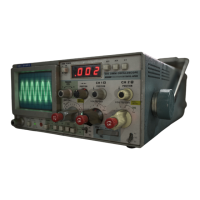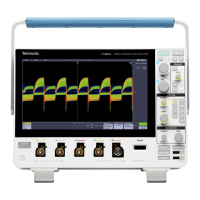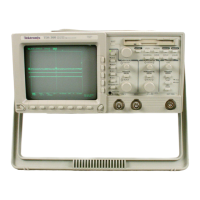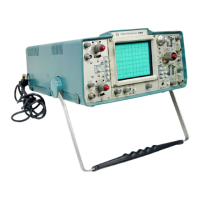Section
3-314
Service
THEORY OF
OPERATION
This section of the manual contains a description of the
circuitry used in the 314 Oscilloscope. The description
begins with a discussion of the instrument using the basic
block diagram shown in Fig.
3-1. Then, each circuit is
described in detail, using adetailed block diagram to show
the interconnections between the stages in each major
circuit and the relationship of the front-panel controls to
the individual stages.
A complete block diagram is located in the Diagrams
section at the rear of this manual. This block diagram
shows the overall relationship of the circuits. A complete
schematic of each circuit is also given in the Diagrams
section. Refer
to these diagrams throughout the following
circuit description for electrical values and relationships.
BLOCK
DIAGRAM
Description
The following discussion is provided to aid in un-
derstanding the overall concept of the 314 before the
individual circuits are discussed in detail. A basic block
diagram of the 314 is shown in Fig.
3-1.
Only the basic
interconnections between the individual blocksare shown
on this diagram. Each block represents a major circuit
within the instrument. The number on each block cor-
responds to the numbers on thecompletecircuit diagram,
which is located at the rear of this manual.
Vertical Amplifier
Signals to be displayed on the crt are applied to the CH
1 or CH
2
input connectors. The input signals are then
amplified by the Channel
1
preamp or the Channel
2
preamp circuit. Each vertical preamp circuit includes
separate vertical deflection factor, position, input coupl-
ing, gain, variable attenuation, and balance controls. A
sample of each channel signal is supplied to the Trigger
Pickoff circuit. The Channel
2
Preamp circuit contains an
invert feature to invert the channel
2
signal displayed on
the crt. The outputs of both Vertical Preamp circuits are
connected to the Channel Switching circuit. This
switching circuit selects the channel(s) to be displayed.
An output signal from this circuit is connected to the
Unblanking Amplifier circuit to blank the switching tran-
sients when in the chopped mode of operation. A sample
of the signal present in the Channel Switching circuit is
supplied to the Trigger
Pickoff circuit.
The output of the Channel Switching circuit is con-
nected to the Vertical Output amplifier through the delay
line. The Vertical Output Amplifier circuit provides the
final amplification for the signal before it is connected to
the vertical deflection plates of the crt.
Triggering
The Trigger pickoff and Trigger Preamplifier circuits
select a trigger signal (determined by the TRIGGERING
Source switch) and produces an output signal that
initiates the sweep signal produced by the Sweep
Generator circuit. The internal trigger signal is selected
from each channel circuit or the Channel Switching
circuit. A sample of the line voltage applied to the
instrument or an external signal applied to the EXT
TRIG
OR HORIZ input connector can also be used to generate a
sweep-starting signal. The Trigger circuit contains level,
slope, coupling, and source controls.
Sweep Generator
The Sweep Generator circuit produces a linear saw-
tooth output signal when inititated by the Sweep Trigger
circuit. The slope of the sawtooth produced by the Sweep
Generator circuit is controlled by the
TIME/DIV switch.
The operating mode of the Sweep Generator circuit is
controlled by the Sweep Modeswitch. In the Auto
modeof
operation, the absence of an adequate trigger signal
causes the sweep to free run. In the NORM mode, a
horizontal sweep is presented only when triggered by an
adequate trigger signal. The Single Sweep mode of
operation allows one (and only one) sweep to be initiated
after the circuit is reset with the RESET button.
The Sweep Generator circuit also produces an un-
blanking gate signal to unblank the crt. This gate is
coincident with the sawtooth produced by the Sweep
Generator circuit. Additionally, the Sweep Generator
circuit produces an alternate trace sync pulse that is
connected to the Channel Switching circuit. This pulse
switches the display between channels at the end of each
sweep when in the
Alt mode of operation.
The output of the Sweep Generator circuit is amplified
by the Horizontal Amplifier circuit to produce horizontal
deflection for the crt in all positions of the TIME/DIV
switch except EXT HORIZ.

